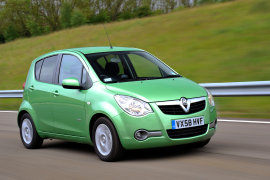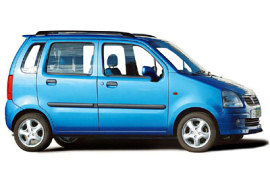VAUXHALL Agila Models/Series Timeline, Specifications & Photos
First production year: 2000
Engines: Gasoline, Diesel
Body style: Hatchback
General Motors continued its project with Suzuki to create and build a small-sized minivan for the European market.
While in mainland Europe the minivan was sold as Opel Agila, in England, it wore the Vauxhall badges. That strategy worked for years, and GM didn't see any problems with doing it all over again since the British brand was better known in the UK than the German-badged vehicles known by the name of Opel.
The urban mini-monocab design concept showed a vehicle fit for tight urban areas. Its short, 3.74 m (12.2 ft) length allowed the car to be parked in tight spots easier than most other vehicles on the market. Moreover, its tall greenhouse and generously-sized doors eased the ingress and egress of the vehicle. At the front, the Agila sported very big headlights, swept back toward the car's A-pillar. At the back, the vertical drop of the tailgate was sweetened by angular-shaped taillights that flanked the vehicle.
Inside, thanks to the high-mounted seats, the Agila offered enough room for four adult-sized occupants. At the front, the two bucket seats provided enough comfort for their occupants. On the dashboard, in front of the driver, the automaker installed an instrument cluster with a big speedometer placed in the middle and several other lights. On the center stack, Vauxhall installed a CD player and the HVAC control panel. In addition, an extension of the center stack hosted the gear stick. On the rear bench was room enough for two passengers, but the trunk in the rearmost side of the car was small, good only for a few shopping.
Under the hood, the two carmakers (GM and Suzuki) decided to give the car a choice of three engines, both gasoline and turbo-diesel. A four-speed automatic was available.
The right-hand drive version of the Opel Agila, the Vauxhall Agila was basically the came car, a rebadged version of the Suzuki Wagon R-Wide produced in Japan.
The first generation was released in 2000 and was sold in over 444,000 units worldwide.
While the boxy exterior design was rather rather dull, the Vauxhall Agila was mostly bought for its practicality. The small MPV-like car was ideal for crowded city transportation thanks to the low fuel consumption it offered. While most city cars were offered in a 3-door configuration, the Agila’s extra 2 doors enhanced its practicality.
Inside, the cabin was fitted with good quality materials. Everything was well laid out, the controls were intuitively placed and easy to action, while the black on white gauges were easy to read. The cloth upholstery was available in different colors to personalise the Agila according to the buyer’s taste.
While practical within city limits, the Agila wasn’t at home on twisty roads or highways. Due to its unusual height, the car’s stability was affected and body roll was present.
The Vauxhall Agila could be equipped with a 1.0-liter or a 1.2-liter gasoline engine, the latter developing 75 hp, just enough to deserve the nameplate of Agila (“agilis” in Latin, agile). Both units were mated with a 5-speed manual transmission.

